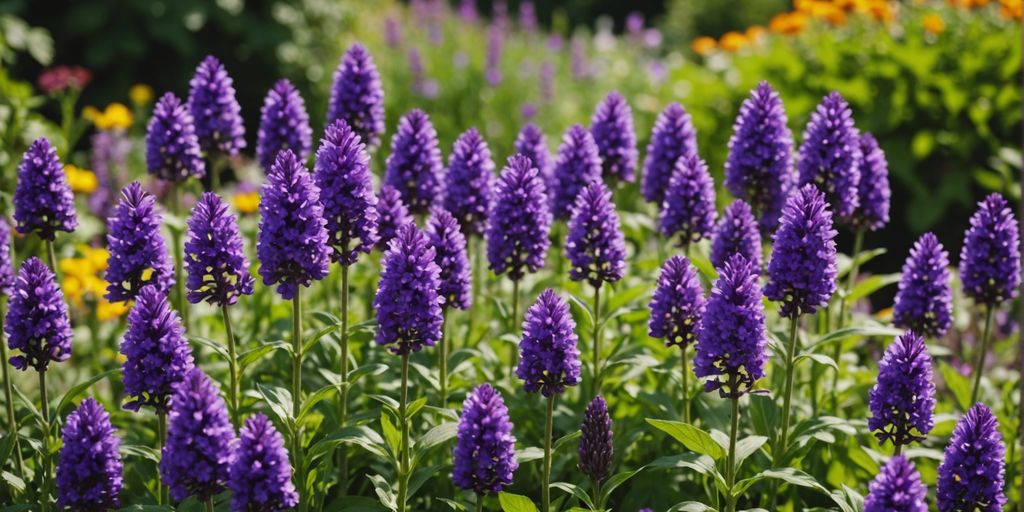Purple perennial flowers are a stunning addition to any garden, providing vibrant color year after year. Whether you prefer the deep, regal shades or the light, luscious tones, these flowers can add depth and richness to your garden. In this article, we will explore the ten best purple perennial flowers that you can plant to enhance your garden’s beauty.
Key Takeaways
- Lavender is known for its aromatic fragrance and beautiful purple spikes.
- Salvia offers long-lasting blooms and is a favorite among pollinators.
- Catmint is a hardy plant that produces clusters of purple flowers.
- Russian Sage features silvery foliage and tall spires of purple blooms.
- Coneflower is a versatile plant that attracts butterflies and bees.
Lavender

Lavender is known for its strong fragrance and light but vibrant purple shades. It grows upward and has flower spikes poking through its pale green foliage. Deer dislike the smell of Lavender, so it makes a great option to plant near vegetables to keep them away.
Lavender is among the most familiar of all plants with purple flowers. Prized for its heavenly scent and essential oil content, lavender is both deer-resistant and sun-loving. Plant it in well-drained soil for the best results. There are many different species and varieties of lavender available. Choose one that’s hardy in your climate as there are many to choose from. Lavandula x intermedia ‘Phenomenal’ and ‘Grosso’ are personal favorites.
Growing Conditions
- Light: Full sun to partial shade
- Soil: Well-drained
- Zones: 5a – 9b
- Bloom Time: Summer
Uses
Lavender can be grown in a rock garden, pollinator garden, or in containers. Clip this charmer and hang it upside down to dry. You can then enjoy its fragrance in the home for months to come.
Varieties
- Lavandula angustifolia ‘Hidcote’: This variety has very dark purple flowers and can be used in cooking and all kinds of herbal crafts.
- Lavandula x intermedia ‘Phenomenal’: Known for its hardiness and vibrant blooms.
- Lavandula x intermedia ‘Grosso’: Another hardy variety with a strong fragrance.
Part of the mint family, lavender prefers to grow in cool summer areas in well-drained soil. The blooms are fragrant, showy summer flowers, and a magnet for bees.
Salvia
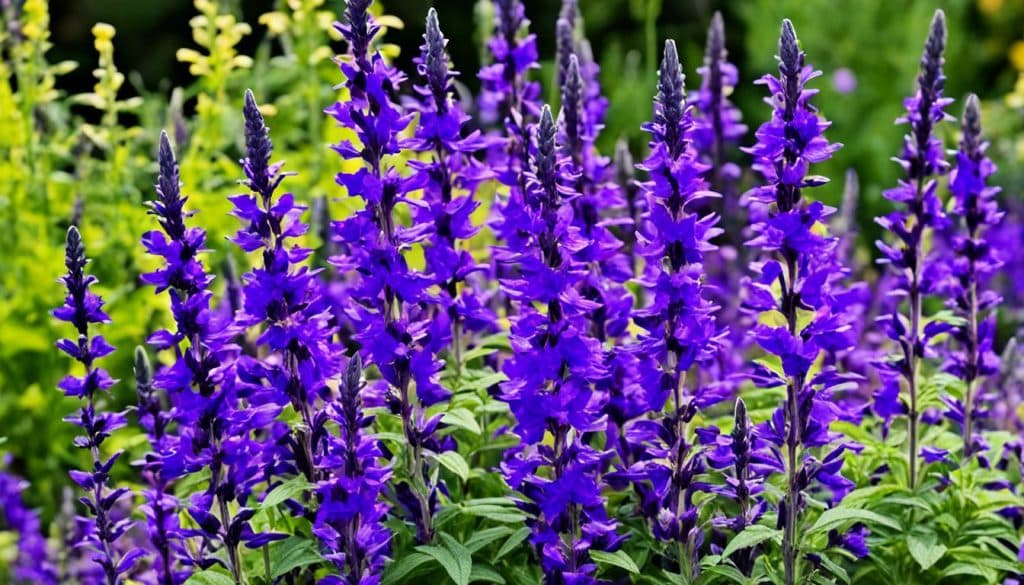
Salvia, also known as sage, is a versatile and hardy perennial that thrives in a variety of garden settings. This attractive plant grows in clusters from 1 ft. to 3 ft. tall and blooms from spring to summer. Salvia features long spikes of small petals in purple, blue, pink, or white, making it a colorful addition to any garden. It is particularly effective as a mass planting in a border garden.
Salvia ‘May Night’ (Salvia x sylvestris) is a popular cultivar known for its showy purple bloom. Plant it in full sun in dry, well-draining soil for the best results.
Growing Zones
- 4a – 8b
Bloom Time
- Spring, summer
Light Requirements
- Full sun to part shade
Special Characteristics
- Named perennial plant of the year in 1997
- Very dark purple blooms are fragrant and last well in flower arrangements
- Drought and deer tolerant
- You can cut back the spent blooms to encourage reblooming in late summer
Catmint
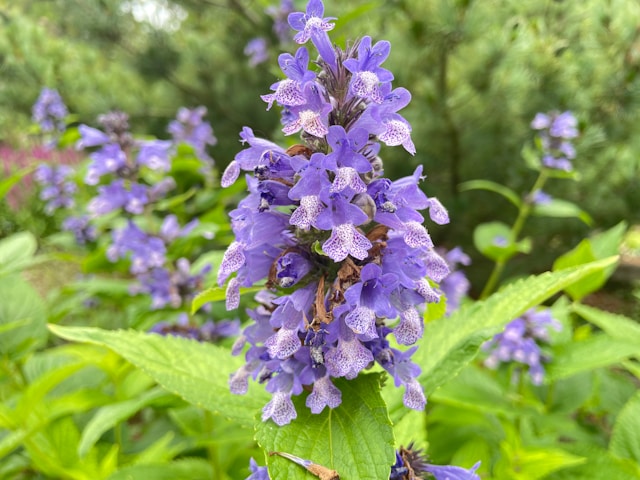
Catmint is a perennial herb of the mint family, as the name suggests. Catmint is easy to grow and is pretty pest-resistant and deer-resistant. This low-growing perennial grows quickly and can thrive in most environments. You can grow Catmint anytime between spring to fall.
Catmint needs full sun and good drainage but is drought-tolerant once established. Its spreading form makes it a good choice for containers, walkway borders, or rock gardens. When spring flowers fade, prune the plant to encourage another wave of flowering.
- Name: Catmint (Nepeta)
- Light: Full Sun
- Growing Zones: 3a – 8b
Catmint prefers full sun; however, they do well with partial shade. They do best in well-drained, humus-rich soil, but some varieties can grow in various soil types. Until established, these plants will need plenty of water, but then Catmints can tolerate periods of drought.
Catmint’s purple flowers and tidy shape make it a more showy garden plant. It thrives in hot, dry climates and blooms all season long. It forms a low, rounded mound of silvery-blue foliage with spikes of perennial purple flowers. It needs little help from you to thrive. It attracts birds and butterflies and makes a nice cut flower. Cut it to the ground in winter.
Russian Sage
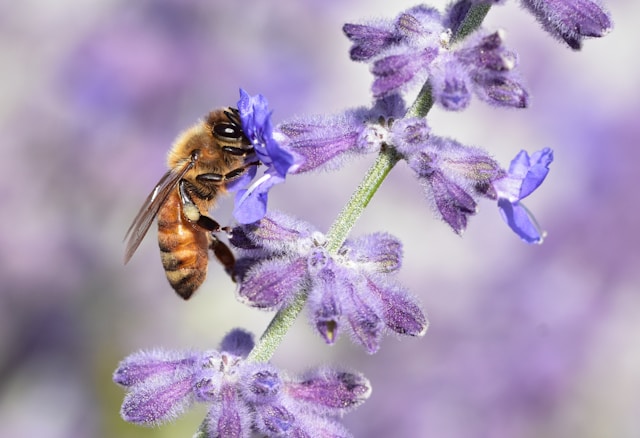
Russian Sage features fuzzy cloud-like flowers that offer a lot of texture in your garden. These plants can also be quite fragrant, especially when crushed or rubbed. Many people describe the fragrance as a mix of Lavender and sage. Although gardeners love the relaxing aroma, deer and pests stay away from it.
Scientific Name
Perovskia atriplicifolia
Soil Type
- Dry to medium
Plant Height
- 18 to 24 inches
Plant Width
- 18 to 24 inches
Sun Exposure
- Full sun
USDA Zones
- 5 to 9
This perennial likes plenty of sun and grows fairly quickly. Adding extra flower food to soil can allow it to bloom even better. Russian sage isn’t too picky with soil types and can even thrive in poor soils. Once established, it is drought-tolerant but can use water in extreme heat or periods of drought.
Coneflower
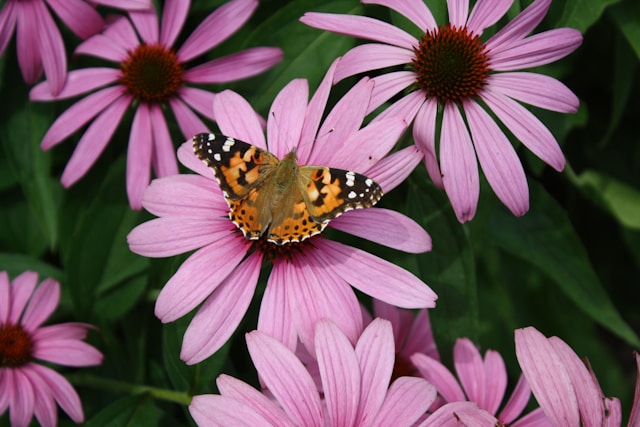
Coneflowers are hardy plants that just about every gardener adds to their display. Each bloom features multiple tiny flowers that are rich in color. Bees, butterflies, and hummingbirds love coneflowers, and some birds enjoy eating their seeds. These perennials bloom early in the spring, with plenty of color.
Characteristics
- Scientific Name: Echinacea purpurea
- Plant Type: Perennial
- Geographic Origin: North America
- Plant Size: 1-3 Feet Tall
- Sun Exposure: Partial Shade to Full Sun
- Plant Zone: 5-8
Growing Conditions
Coneflowers can withstand a variety of temperatures but do not do well in humid or rainy climates. These flowers can do well in various soil types, as long as it doesn’t get too wet. Coneflowers can tolerate drought but do best with regular watering until they are established. Adult Echinaceas are only thirsty during periods of droughts.
Bloom Time
Purple coneflower is a member of the Asteraceae (daisy) family and native to the central and eastern United States. The plant can grow 3 to 4 feet tall and produce pinkish-purple flowers from early summer through mid-fall. Many cultivars have been bred to produce white, pink, orange, and red blooms.
The purple coneflower (E. purpurea) is the most common and readily available. The flowers measure 2 to 4 inches in diameter and have a mounded, brown, central cone.
Clematis
Clematis is an eye-catching perennial that will liven up any garden. The flowers on this plant are large, reaching up to 8 inches in diameter. This perennial is considered a “repeat bloomer,” meaning a young plant may bloom in both July and September. As a member of the Buttercup family, Clematis has over 300 species with various hybrids to choose from.
Plant Type
Clematis is a perennial, deciduous vine that produces elegant, lavender-colored flowers on new growth and they typically bloom from midsummer to fall.
Geographic Origin
Clematis is native to the United States and can be found in various regions across the country.
Plant Size
Clematis can grow up to 30 feet in length, making it ideal for trellises or fences. It can also be allowed to scramble downward, creating a cascading effect.
Sun Exposure
Clematis thrives in full sun but can also tolerate part shade. When caring for clematis, read the grower’s tag as some varieties prefer shady areas.
Plant Zone
Clematis is suitable for growing in zones 4-9, making it a versatile choice for many gardeners.
Special Characteristics
Clematis flowers can be 4 to 7 inches wide and attract bees, butterflies, and hummingbirds. They are also deer and rabbit-resistant, making them a hardy choice for any garden.
Clematis is a vining flower that’s super easy to grow and is available in a wide variety of flowers and colors. They’re also relatively inexpensive and make a colorful display for anyone on a budget. Typically grown up a trellis or scrambling over a fence, clematis can be allowed to scramble downward. I planted one near the top of my pond’s waterfall and I let it cascade down the rocks right next to the water. When selecting clematis, look for ‘Cezanne’, ‘Blue Explosion’, or ‘Blue Angel’ for purple blooms.
Iris
The Iris germanica, commonly known as the German bearded Iris or Flag, is a resilient and easy-to-care-for perennial. These flowers thrive in hardiness zones 3 to 10 and prefer full sun. They can grow up to 2 feet tall and 1 foot wide. The bearded iris is known for its vibrant colors, including royal purple, and the fuzzy “beards” atop the falls.
Characteristics
- Plant Type: Perennial
- Geographic Origin: Europe
- Plant Size: 12-40 inches
- Sun Exposure: Full Sun
- Plant Zone: 3-10
Growing Conditions
Plant bearded iris in well-drained, humus-rich soil. Keep the soil moist but avoid overwatering. These plants can tolerate some periods of drought once established. For best results, plant in wet or moist soil, especially if you have a garden near water features or wetlands.
Maintenance
- Watering: Keep soil moist but avoid overwatering.
- Sunlight: Full sun to partial shade.
- Soil: Well-drained, humus-rich soil.
- Division: Divide every three to four years to avoid overcrowding.
The bright purple flowers top bicolor foliage of green and deep purple, making them ideal for adding a splash of color to your garden.
Benefits
- Deer-resistant
- Drought-tolerant
- Attracts butterflies and hummingbirds
- Great for cut flowers
Allium
Allium plants come from the onion family and contain a flower head with clusters of florets. With Alliums, the flowers may have a rounded, oval, or cascading shape. Flowers come in a wide range of vibrantly colored blooms, including purple. You can also choose from various heights ranging from just a few inches to a few feet tall. Flowers on Allium plants often grow on the end of stalks with little to no leaves.
Characteristics
- Plant Type: Perennial
- Geographic Origin: Central Asia
- Plant Size: 6 inches to 3 feet
- Sun Exposure: Prefers Full Sun
- Plant Zone: 3-8
Growing Conditions
Alliums are easy to care for if you plant them in well-drained soil in an area with plenty of sunshine. You won’t need to water, weed, or fertilize it often. Typically rainfall will take care of Allium’s watering needs, but you may need to water your plants during a drought. Organic mulch can also enhance the health of your Allium flowers.
Popular Varieties
Choose A. aflatunense, A. cristophii, or A. caeruleum bulbs. Ornamental onions are great for sunny border gardens, rock gardens, or as a mass planting.
Clump-forming allium, also known as ornamental onion, is truly impressive in the garden. Delightful, purple balls grow atop sturdy stems and come in a variety of heights. My mother loved these for the architectural element they add to the landscape, and likewise, I share her love of them.
Geranium
Hardy geraniums, also known as Cranesbill, are a delightful addition to any garden. These perennials are a hybrid cultivar of G. sanguinium and G. procurrens, featuring deep magenta-purple flowers. They have a sprawling habit, making them excellent as groundcover or edging plants. To keep the plant blooming, deadhead often or trim back before the summer heat arrives.
Characteristics
- Name: Hardy Geranium (Geranium x Dilys)
- Light: Full sun, dappled sunlight
- Growing Zones: 4a – 8b
- Bloom Time: Spring, summer
Geranium ‘Orion’
- Common Name(s): Cranesbill, Hardy Geranium
- Hardiness Zone: 5 to 8
- Sun Requirements: Full Sun to Part Shade
- Size: 2 ft x 3 ft
- Special Characteristics: This one has a beautiful free-flowing growing habit and cottage garden feel. The small delicate flowers sway atop lacy green foliage that sometimes turns shades of red in the fall. They are not bothered by deer and butterflies love them.
Care Tips
- These flowers are drought tolerant, so be sure not to overwater them.
- Plant in loose, well-drained soil.
- Regularly watering allows you to enjoy your blooms longer.
Hardy geraniums are a versatile and resilient choice for gardeners, offering beauty and ease of care.
Veronica
Veronica, also called Speedwell, is a carefree and easy-to-grow perennial with long spikes of small petals in purple, blue, pink, or white. This plant is a favorite among gardeners due to its vibrant colors and minimal maintenance requirements.
Planting and Growing
Plant Speedwell in late spring, once the soil is warm. These flowers grow pretty quickly, sometimes reaching their full height before the end of their growing season. Veronica prefers lots of sun but will grow well in partial shade. Grow Speedwell in well-drained soil as overly wet soil can kill them for best results. Veronicas are pretty drought-resistant but should be in an area that protects them from strong, damaging winds.
Varieties
- MAGIC SHOW® ‘PURPLE ILLUSION’ VERONICA: This variety matches the habit and flower size of ‘Wizard of Ahhs’, but with rosy purple flowers. Dark green leaves form a thick foliar canopy, leaving the plant with substance after it has finished blooming. Requires vernalization to bloom.
- Royal Candles: Resistant to powdery mildew, this variety reaches about 12 inches in height and has pointy spires of densely packed purple flowers that open from the bottom up. It remains in bloom for weeks.
- Creeping Speedwell (Veronica x ‘Waterperry Blue’): A low-growing perennial with purple flowers, this variety makes a great ground cover. Though it’s only in bloom for a short time each spring, it looks lovely year-round and is semi-evergreen.
Care Tips
- Sunlight: Full to part sun
- Soil: Well-drained
- Watering: Drought-resistant but avoid overly wet soil
- Maintenance: Light haircut in early spring for creeping varieties
Veronica is an old-fashioned, deer-resistant, purple flowering perennial that gardeners have loved for generations.
Conclusion
Incorporating purple perennial flowers into your garden is a delightful way to add depth, richness, and a pop of color that lasts year after year. With a wide range of options from tall and majestic to short and charming, there is a purple perennial to suit every garden style and size. Whether you prefer the dark and regal hues or the light and luscious shades, these flowers are sure to make a statement. As you plan your garden, consider the site preferences, growth habits, and hardiness of each plant to ensure a thriving and vibrant display. Happy gardening!
Zaki Infitar is the driving force and creative mind behind GreenBuilt.co. As a self-taught gardener with an unwavering passion for all things green, Zaki’s journey into the world of gardening is a testament to his dedication and love for nature.

